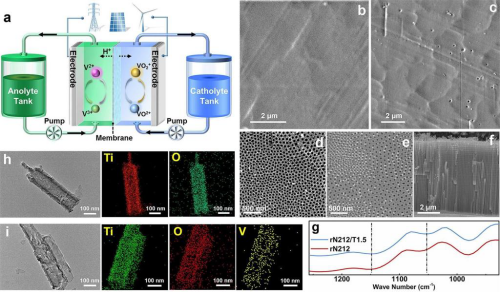Recently, a low-cost, high-performance perfluorosulfonic acid-based composite ion exchange membrane, Nafion/TiO2 nanotube composite membrane, was developed and applied to vanadium redox flow batteries, co-led by Prof. Lidong Sun from Chongqing University, Prof. Mei Ding and Prof. Chuankun Jia from Changsha University of Science and Technology. The superhydrophilic nature of TiO2 nanotubes enabled their uniform dispersion in the Nafion matrix and exhibited good inhibition of vanadium ion permeation. At a current density of 120 mA cm-2, the vanadium redox flow battery achieves an energy efficiency of 84.4% with more than 1400 stable cycles lasting more than 518 hours, which is much higher than commercial Nafion membranes. The results of the study were published online on March 29, 2020 in the Wiley Press journal Advanced Energy Materials under the title Hybrid Membranes Dispersed with Superhydrophilic TiO2 Nanotubes Toward Ultra-Stable and High-Performance Vanadium Redox Flow Batteries.
Vanadium redox flow battery is one of the most promising technologies for large-scale energy storage, which can be used both as an energy storage device for clean energy generation and as an auxiliary means for grid peaking to achieve safe and efficient grid operation. As one of the key materials of redox flow battery, ion exchange membrane determines the performance and cost of the battery; it isolates the positive and negative electrodes and electrolyte to prevent electrode contact short circuit and electrolyte cross contamination, while allows balanced ions to pass freely through the membrane to maintain the overall electrical neutrality of the battery. Currently, the low ion selectivity of the Nafion series of diaphragms, commonly used in vanadium redox flow batteries, has seriously affected the development of vanadium redox flow batteries. In response, the research team used electrochemical anodic oxidation to prepare TiO2 nanotubes and applied their superhydrophilicity to modulate the Nafion membrane structure, reduce the use of polymers and ultimately obtain high-performance ion-exchange membranes for vanadium redox flow battery. This technology significantly improves the ion-selective performance and reduces the cost of the diaphragm, which has a wide range of application prospects.
The research work was financially supported by the National Natural Science Foundation of China, the Fundamental Research Funds for the Central Universities, the 100 Talented Team of Hunan Province, the “Huxiang high‐level talents” program, Open Fund of the State Key Laboratory of Mechanical Transmission and National Engineering Laboratory of Highway Maintenance Technology. Jiaye Ye, a joint PhD student of College of Materials Science and Engineering of Chongqing University and Changsha University of Science and Technology, is the first author of the paper, and Prof. Lidong Sun from College of Materials Science and Engineering of Chongqing University, Prof. Mei Ding and Prof. Chuankun Jia from Changsha University of Science and Technology are the co-corresponding authors.
